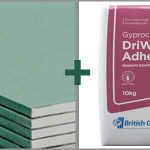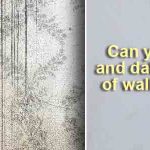If you’re carrying out renovation works in your home, one thing you may want to do is hide pipework. The aim here would be to create a clean and modern look.
With stud walls this is relatively easy, but what about solid walls? can you have pipes behind dot and dab plasterboard for example?
Running pipes behind dot and dab is certainly possible. However, there are certain things to think about, to ensure you complete the job correctly. You can hide both copper and plastic pipes behind dot and dab. But you will need to think about protecting the pipes. As well as making sure they can be found later.
The pipes might need to be chased into the wall or secured with clips directly onto the wall. If they are chased into the wall, they will need a clearance of 10mm for attaching plaster boards. Extra space will be required if they are attached directly to the wall. Copper pipes will also need protection from dot and dab to stop corrosion.
Can You Plasterboard Over Copper Pipes?

Yes, it is possible to plasterboard over copper pipes using the dot and dab method. When you choose this option, you must think about several things, as copper pipe is different to plastic pipe.
There are two options available here. The first is to use 15mm copper piping that you surface fix to the wall. While this isn’t the wrong option, it does make things more difficult. This is because it will increase the depth you need behind the plasterboard.
With clips and the thickness of the pipe, you are going to need a larger depth which means you will need a thicker dab to allow for the pipes. You will also need to consider the plumb of the wall as this could cause an issue with the depth behind the plasterboard too.
You will also need to make sure that the copper pipe sits as tight to the wall as possible. The plasterboard should not touch the copper pipe, as this can lead to corrosion, water damage and even an increase in noise.
Usually, the best option will be to chase the pipe into the wall. This will take more work but will create a better finish overall. It will also mean you can use less adhesive and avoid a large gap behind the plasterboard.
If you take this option, the copper pipe will require a clearance of 10mm. You will need to make sure that the pipe is protected from corrosion from cement in the brickwork and the drywall adhesive. Therefore, you should look to cover the pipe in a protective tape, such as Denso tape.
One final thing to consider, is building regulations. All vertical chases should be no deeper than 1/3 of the wall thickness. For horizontal chases, they should not be deeper than 1/6 of wall thickness.
Does Dot and Dab Corrode Copper Pipes?
There is a possibility that dot, and dab will corrode copper pipes. Copper can corrode when it encounters mortar and some adhesives such as drywall adhesive. This is a process that can take several years, but eventually corrosion can take place.
If you are going to place dot and dab in contact with copper pipes, then you will need to protect the pipe. It is recommended that you use tubular hair felt lagging. If you cannot find this, then hair felt on a roll can be placed over the pipe. This will help to stop corrosion and contact with the adhesive.
Dot and dab can also cause corrosion in other ways. For example, if pipes are set in the dot and dab adhesive, this can also cause problems. The movement of pipes can cause friction. As they heat up and cool, they expand and contract. This causes them to move and rub against the adhesive, which could cause them to fail.
Can You Have Gas Pipes in Dot and Dab Walls?
NOTE: Only gas safe individuals should be installing gas pipes. Do not attempt this work yourself if you are not legally qualified to work on gas appliances
It is possible to have gas pipes in dot and dab walls. However, you should consider the possible risks. It may help the aesthetics of your home. But there is also the risk of a gas leak.
When a gas fitter chooses this option, the gas pipe will usually be chased into the wall and wrapped in protective tape. After this is done, the entire pipe will be enclosed with drywall adhesive.
In theory the adhesive should meet the back of the plaster board, enclosing the gas pipe. Due to this, if the pipe is punctured from outside with something like a screw or a nail, the gas should leak out into the room, and not fill the void behind the boards.
However, it’s still important to recognise that gas pipes cannot be run in an unventilated void. You will be required to ventilate, so that there is no build-up of gas. Furthermore, if there is a gas leak, you’ll be able to smell much sooner with proper ventilation.
One other thing to consider, is electric cables. These should not be run alongside gas pipes, to help avoid the risk of explosions.
The main thing to remember here, is you should hire a gas safe professional to carry out this type of work. DO NOT try fitting gas pipes yourself.
Conclusion
Yes, it is possible to have pipes behind dot and dab plasterboard. The approach you take will depend on the type of piping and what it is used for.
If you are hiding water pipes then it’s possible to either chase them into the wall or secure them on the surface.
Gas pipes come with additional risk, so the job must be handled correctly and be carried out by someone who is legally qualified gas safe.
Whatever you are installing, you’ll also have to ensure you follow all building regulations. This will ensure your home remains safe and that you do not break the law.




